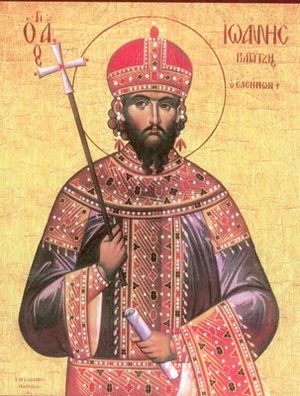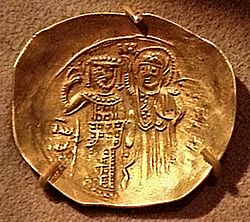John III Doukas Vatatzes facts for kids
Quick facts for kids John III Doukas Vatatzes |
|
|---|---|
| Emperor and Autocrat of the Romans | |

15th-century portrait of John III
|
|
| Emperor of Nicaea Claimant Byzantine Emperor |
|
| Reign | December 1221 – 3 November 1254 |
| Predecessor | Theodore I Laskaris |
| Successor | Theodore II Laskaris |
| Born | c. 1192 Didymoteicho, Byzantine Empire |
| Died | 3 November 1254 (aged 62) Nymphaion, Byzantine Empire (now Kemalpaşa, Izmir, Turkey) |
| Burial | Monastery of Sosandra, region of Magnesia |
| Spouse | Irene Laskarina Anna of Hohenstaufen |
| Issue | Theodore II Laskaris |
| House | Vatatzes |
| Father | Basil Vatatzes (?) |
| Mother | Unknown |
| Religion | Eastern Orthodox |
John III Doukas Vatatzes (born around 1192 – died November 3, 1254) was a powerful Emperor of Nicaea. He ruled for over 30 years, from 1221 to 1254. His rule was very important for the future of the Byzantine Empire. He helped make Nicaea strong and ready to take back its old capital, Constantinople. His son, Theodore II Laskaris, became emperor after him.
Contents
Life of John III Vatatzes
Early Life and Family Background
John Doukas Vatatzes was born around 1192 in a place called Didymoteicho. His father was probably a general named Basil Vatatzes. His mother was a cousin of two emperors, Isaac II Angelos and Alexios III Angelos. John had two older brothers. One of them, Isaac Doukas Vatatzes, was born in 1188.
Becoming Emperor of Nicaea
John was a very good soldier. Around 1216, Emperor Theodore I Laskaris chose John to marry his daughter, Irene Laskarina. This marriage also made John the heir to the throne. This decision meant that other members of the emperor's family would not become rulers.
When Emperor Theodore I died in November 1221, John III became emperor. Some people did not agree with this. He had to fight against them to keep his power. This struggle ended with a big battle called the Battle of Poimanenon in 1224. John won this battle, even though his opponents had help from the Latin Empire of Constantinople.
Expanding the Empire
After his victory, John III gained land from the Latin Empire in 1225. He then moved into Europe and took control of Adrianople. However, Theodore Komnenos Doukas, the ruler of Epirus and Thessalonica, soon took Adrianople from John.
Things changed when Ivan Asen II of Bulgaria defeated Theodore in 1230. This removed the threat from Thessalonica. John III then made an alliance with Bulgaria against the Latin Empire.
In 1235, this alliance led to an important marriage. John III's son, Theodore II, married Elena of Bulgaria, who was Ivan Asen II's daughter. In the same year, the Bulgarians and Nicaeans worked together. They tried to attack Constantinople in 1236. After this, Ivan Asen II became neutral, leaving John III to fight on his own.
Later Victories and Death
Even with some setbacks in 1240, John III kept expanding his empire. When Ivan Asen II died in 1241, John III took advantage of the situation. He gained control over Thessalonica in 1242 and later fully took over the city in 1246. He also gained much of Bulgarian Thrace.
By 1247, John III had a strong hold on Constantinople. In his last years, Nicaean power reached far to the west. He tried to stop the expansion of Epirus. Some of Epirus's allies even switched sides to support John III in 1252.
John III died in Nymphaion in 1254. He was buried in the Sosandra monastery, which he had built himself.
John III's Family Life
John III Doukas Vatatzes married his first wife, Irene Lascarina, in 1212. She was the daughter of the previous emperor, Theodore I Laskaris. They had one son, who later became Emperor Theodore II Doukas Laskaris. Sadly, Irene had an accident while riding a horse. She was so badly hurt that she could not have any more children.
Irene later became a nun and passed away in 1240. John III then married his second wife, Constance II of Hohenstaufen. She was the daughter of Emperor Frederick II. They did not have any children together.
Legacy and Sainthood
| John Vatatzes the Merciful, Emperor of the Romans | |
|---|---|

St. John Vatatzes the Merciful King, Emperor of Nicaea and "the Father of the Greeks."
|
|
| Emperor | |
| Venerated in | Eastern Orthodoxy |
| Major shrine | Didymoteicho, Western Thrace and Nymphaion (Ionia) modern-day Kemalpaşa, Turkey |
| Feast | 4 November |
| Attributes | Imperial Vestment |
John III Doukas Vatatzes was a very successful ruler. He created a strong foundation for Nicaea to eventually take back Constantinople. He managed to keep peace with his powerful neighbors, Bulgaria and the Sultanate of Rum. He also had good relationships with other empires, like the Holy Roman Empire and the Papacy. His army included soldiers from different places, like Franks and Cumans.
John III expanded Nicaean control into Europe. By the end of his rule, he had taken over Thessalonica and gained land from Bulgaria and Epirus. He also expanded Nicaean power over much of the Aegean Sea. He even took the important island of Rhodes. He supported efforts to free Crete from Venetian control.
People also praised John III for making his empire rich and prosperous. He encouraged justice and charity. Even though he had epilepsy, he was an active leader in both peace and war. He believed he was the true heir to the Roman Empire. He was also known for his big harvest festivals.
About 50 years after he died, John III was made a saint. He is known as John the Merciful. People remember him every year on November 4. A temple was built in his honor in Nymphaeum. His worship as a saint quickly spread in western Asia Minor. Today, a festival called Vatatzeia is held in his birth city of Didymoteicho on his feast day.
Generations after John Vatatzes called him "the Father of the Greeks."
Legend of the Reposed King
According to a legend, John III's body, which was said to be incorrupt, was moved to Constantinople. This happened after the city was taken back from the Franks. The legend of the "reposed King" became connected with him. When the fall of Constantinople to the Ottoman Turks happened, his body was hidden in a secret underground place. A family of Crypto-Christians guarded it for many generations. The legend says that since then, he has been waiting for Constantinople to be freed again.
See also
 In Spanish: Juan III Ducas Vatatzés para niños
In Spanish: Juan III Ducas Vatatzés para niños


